Blog
Changwen is a leading cooking utensils manufacturers. We supply high quality stainless steel cooking pots and pans to all over the world. We can also customize the local hot-selling stainless steel pots and pans. Please send your requirements to Changwen.
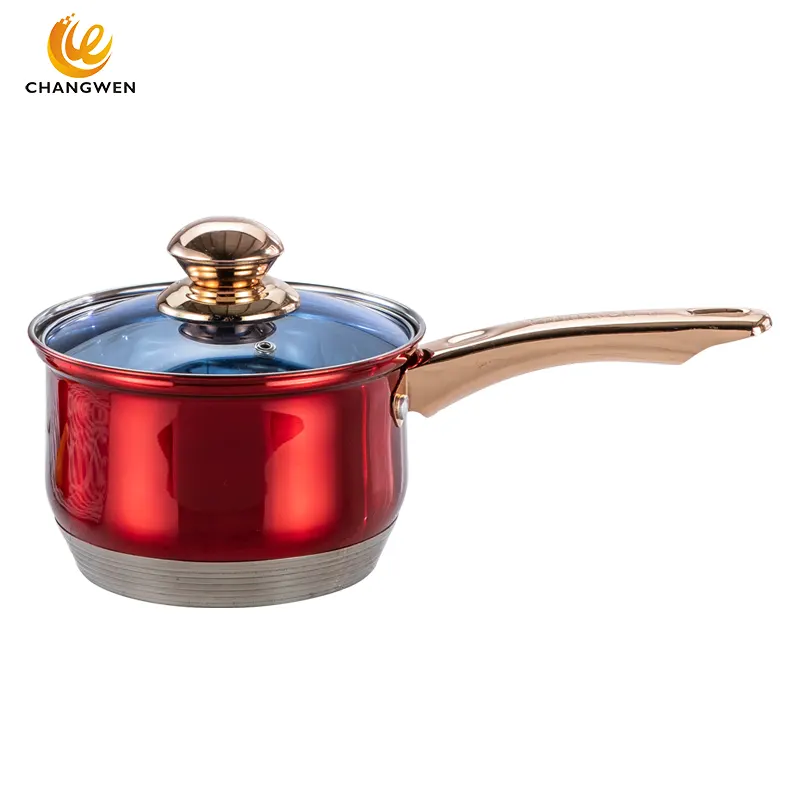
The Ultimate Guide to the Sauce Pan
What is a sauce pan?
A sauce pan is a small to medium-sized pan with a handle and moderate depth (about 8-12 cm), designed for cooking sauces, stews or heating liquids, and distributing heat evenly. It is different from a frying pan (shallow and wide), a sauté pan (deeper, suitable for stir-frying) and a stock pot (large-capacity stew pot).
Uses of Sauce Pan
Due to its unique design, Sauce pan has many uses, mainly including:
Making sauces and stews: Its deeper pot body can hold enough liquid and ingredients, suitable for long-term slow stewing or making various sauces.
Heating liquids: Such as milk, soup, etc., the deep flat bottom design of Sauce pan makes heating more even and avoids liquid splashing.
Cooking small dishes: For singles or small families, Sauce pan is of moderate size and suitable for cooking small dishes.
Multi-functional cooking: In addition to the above main uses, Sauce pan can also be used for frying, stir-frying, steaming and other cooking methods to meet the cooking needs of different dishes.
Functional differences between Sauce Pan and other pots
| Type | Sauce Pan | Frying Pan | Sauté Pan | Stock Pot (soup bucket) |
|---|---|---|---|---|
| Capacity | 1.5-4L | 2-5L (flat bottom and wide surface) | 3-8L (shallow body and wide mouth) | 5L or more (deep cylindrical) |
| Bottom shape | Round bottom/conical bottom | Flat bottom | Slightly concave round bottom | Round bottom/deep cylindrical bottom |
| Main functions | Liquid slow cooking, sauce preparation</t d> | High temperature frying, fast cooking | Quick stir-fry, stir-fry | Large amount of soup stew |
| Heat conduction | Uniform heat conduction (suitable for temperature control) | High thermal conductivity (grease is required for anti-sticking) | Medium and high thermal conductivity (mostly metal materials) | Large area heat conduction (suitable for long-term heating) |
| Typical materials | Stainless steel, aluminum alloy | Cast iron, carbon steel, copper | Cast iron, carbon steel, stainless steel | Cast iron, stainless steel, aluminum |
Key differences:
Sauce Pan vs. Frying Pan: The former focuses on liquid control, while the latter emphasizes fast heat transfer and non-stick properties.
Sauce Pan vs. Sauté Pan: The latter is deeper and has slightly sloping sides, which is suitable for stir-frying rather than long stewing.
Sauce Pan vs. Stock Pot: The latter has a larger capacity and is used for boiling soup or large amounts of liquid.
Sauce Pan Manufacturing Process
The manufacturing process of a Sauce Pan usually includes the following steps:
Material selection: According to the design requirements and purpose of the product, select the appropriate metal material as the main material of the pot body. Stainless steel is often selected for its good corrosion resistance and aesthetics; aluminum is favored for its excellent thermal conductivity; cast iron is suitable for some dishes that require long-term heating due to its good heat preservation and durability.
Forming: The selected material is processed into the required pot body shape through processes such as stamping, casting or forging. In this process, the processing parameters need to be strictly controlled to ensure the dimensional accuracy and surface quality of the pot body.
Surface treatment: The processed pot body is polished, ground and other surface treatments are performed to improve its smoothness and aesthetics. For stainless steel pot bodies, mirror polishing can also be performed to achieve a brighter effect.
Handle and pot lid production: Handle and pot lid are made according to design requirements. The handle is usually made of metal or plastic to ensure its firmness and comfort; the pot lid is usually made of glass or metal to facilitate observation of the cooking status of the ingredients in the pot.
Assembly and testing: Assemble the pot body, handle, lid and other parts, and conduct quality testing to ensure the quality and safety of the product. The testing content includes but is not limited to dimensional accuracy, sealing performance, heat resistance, etc.
What technologies are used in the manufacture of sauce pans?
Honeycomb anti-stick technology: The milk pan uses honeycomb anti-stick technology. By etching precise concave and convex textures in the pot wall, a honeycomb mesh structure is formed. This design is not only anti-stick and durable, but also makes complementary food easier for the baby to absorb.
One-piece die-casting process: This process makes the milk pan more sturdy and durable. The non-splicing design is not only beautiful and generous, but also more assured to use.
Three-layer composite structure: The high-end milk pan adopts a three-layer composite structure, including 5% of titanium as the contact layer, pure aluminum as the middle layer, and magnetic 430 stainless steel as the bottom layer. This design makes the pot body sturdy and durable, heat conduction is uniform, and it has the advantages of antibacterial, corrosion resistance, and easy cleaning.
Hammered snowflake pattern: This technology is used to enhance the beauty and uniformity of heat conduction of the milk pan. By hammering the snowflake pattern, not only the beauty of the pot body is increased, but also the heat conduction can be quickly and evenly reduced.
What material is good for sauce pan
The materials of sauce pan mainly include medical stone, cast iron, glass, ceramic and stainless steel, etc.
1. Stainless Steel
Advantages:
Corrosion resistance: strong acid and alkali resistance, suitable for cooking acidic ingredients such as tomato sauce and lemon juice.
No coating risk: no need to worry about coating shedding, safe and hygienic.
Durability: long life, can be used repeatedly for decades.
Compatibility: suitable for all stoves (gas, induction cooker, electric ceramic stove).
Disadvantages:
Uneven heat conduction: pure stainless steel needs to be matched with aluminum/copper composite bottom to improve thermal efficiency.
Weight: heavy, easy to fatigue after long-term stir-frying.
Applicable scenarios:
Daily use in the home, commercial kitchen (such as making sauce in a western restaurant).
2. Aluminum Alloy
Advantages:
Fast heat conduction: 3 times faster than stainless steel, suitable for sauces or soups that heat up quickly.
Lightweight: easy to operate, suitable for women or the elderly.
High cost performance: Affordable price, suitable for users with limited budget.
Disadvantages:
Easy to oxidize: Long-term contact with acidic food may change color (anodizing treatment is required).
Not resistant to high temperature: May soften and deform over 200℃.
Applicable scenarios:
Home cooking sauces, stews, frying (non-stick coating is required).
3. Copper
Advantages:
Extreme thermal conductivity: The fastest heat conduction speed and precise temperature control (suitable for caramel and cream sauce).
Aesthetics: Retro appearance, suitable for display kitchens.
Antibacterial: Natural antibacterial, reducing the risk of food contamination.
Disadvantages:
Expensive: Pure copper pots are expensive and complicated to maintain.
Requires regular maintenance: Easy to oxidize and turn black, and requires a tin layer or regular polishing.
Applicable scenarios:
Professional chefs, users who pursue the ultimate cooking experience.
4. Cast Iron
Advantages:
Strong heat storage capacity: long-lasting heat preservation, suitable for slow cooking or frying (such as Dutch oven).
Durability: almost lifelong use, the more you use it, the smoother it becomes.
Safe without coating: physical anti-stick, suitable for healthy eating.
Disadvantages:
Heavy weight: difficult to carry, difficult for women to operate with one hand.
Need to open the pot for maintenance: need to oil regularly to prevent rust, and many cleaning restrictions.
Applicable scenarios:
American country style kitchen, outdoor camping (need to be matched with gas stove).
5. Composite materials (aluminum-clad steel/copper-clad steel)
Advantages:
Balanced performance: the outer layer of stainless steel/copper is beautiful and corrosion-resistant, and the inner layer of aluminum/copper conducts heat quickly.
High cost performance: the cost is lower than pure copper/aluminum, suitable for the mid-end market.
Disadvantages:
Complex process: the welding point is easy to hide dirt and dirt, and needs to be thoroughly cleaned.
Thickness difference: inferior products may be delaminated and fall off.
Applicable scenarios:
Daily use at home, taking into account both performance and appearance.
6. Ceramic Coating
Advantages:
Healthy and chemical-free: does not contain PTFE/PFOA, suitable for sensitive people.
Strong non-stickiness: close to the experience of non-stick pans in initial use.
Lightweight and easy to clean: the weight is between aluminum and stainless steel.
Disadvantages:
Poor wear resistance: metal spatulas are easy to scratch the coating, and the life span is about 1-3 years.
Not resistant to high temperatures: harmful gases may be released above 260℃.
Applicable scenarios:
Healthy eating families, users who cook occasionally.
Material selection comparison table
| Material | Thermal conductivity | Durability | Price | Applicable people |
|---|---|---|---|---|
| Stainless steel | ★★☆☆☆ | ★★★★★ | Medium and high | Families pursuing safety and durability |
| Aluminum alloy | ★★★★☆ | ★★★☆☆ | Medium and low | Users with limited budget and focusing on lightness |
| Copper | ★★★★★ | ★★★☆☆ | High | Professional chefs, those who pursue the ultimate experience |
| Cast iron | ★★★☆☆ | ★★★★★ | Medium-high | Outdoor enthusiasts, slow cookers |
| Composite materials | ★★★★☆ | ★★★★☆ | Medium | Practical approach to balance performance and cost |
| Ceramic coating | ★★★☆☆ | ★★☆☆☆ | Low | Health-sensitive, short-term users |
Purchase suggestions
Daily household use: give priority to stainless steel composite bottom or aluminum alloy + non-stick coating, taking into account both performance and cost-effectiveness.
Professional kitchen: invest in copper or cast iron pots to improve temperature control and cooking accuracy.
Health-sensitive: choose ceramic coating or food-grade stainless steel to avoid chemical coating risks.
Do you want to custom sauce pan?
We are a professional sauce pan manufacturer and can custom your sauce pan. Compared with similar products on the market, our products have incomparable advantages in performance, quality, appearance, etc. and enjoy a good reputation in the market. Our product quality is stable and there are almost no quality problems. We undergo strict quality inspections before leaving the factory.
Changwen is a factory known for its high-quality kitchenware, always putting health first. Its sauce pan is made of 316L stainless steel, which brings a healthier choice for cooking. Our sauce pan is not only durable and of good quality, but also very cost-effective, which is very suitable for wholesalers. We provide a variety of materials and styles to choose from, and can also be customized according to your needs.
Popular Blog
The Ultimate Guide to the Sauce Pan
How Do You Keep Food From Sticking to Stainless Steel
Why choose stainless steel for cookware?
Which One is Better or best for value,3 Ply or 5 Ply?
How to clean stainless steel products
How to deal with rusty cast iron pot
Comparison of three-layer cookware and stainless steel cookware
Features of Capsule Bottom Stainless Steel Cookware
How to open the pot and raise the pot?
What Cookware Is Best for Gas Stoves? A Comprehensive Guide
Tags
Recommend Products
-
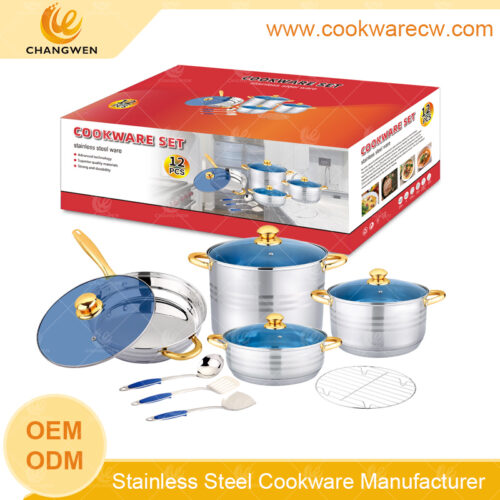
popular stainless steel 12pcs cookware set pots and pans casserole fry pan with kitchenware tools and wire reack CW-M1208
-
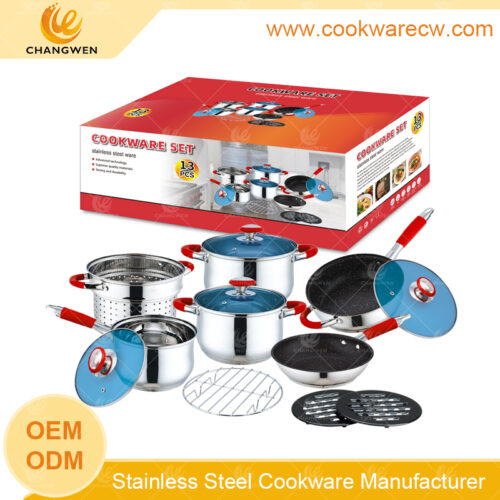
High quality pots wholsesale stainless steel pasta pot fry pan nonstick set saucepan casseroles with red silicone steamer rack heat insulation black mats CW-M1303G
-
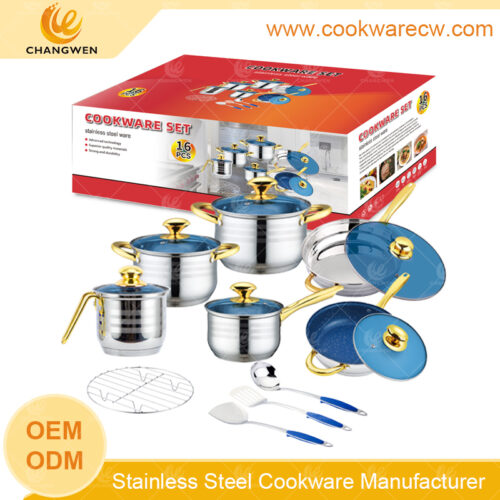
Heavy high quality stainless steel pots and pans 16pcs cookware set with gold plated nonstick fry pan steamer rack and slotted turner spatula ladle CW-M1601
-
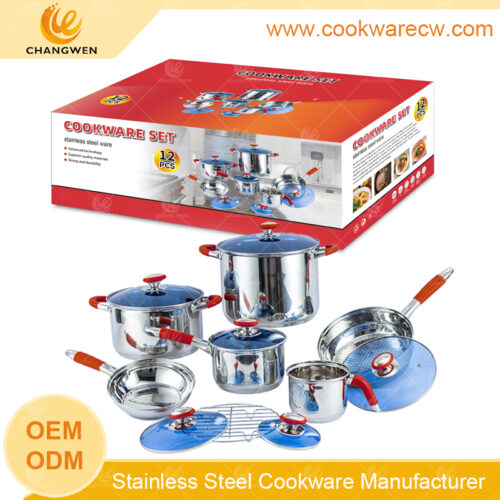
Hotsale 12pcs stainless steel cooking set popular pots and pans kitchen soup stock pot with red silicone steamer rack China factory customized color box CW-M1306G-03
-
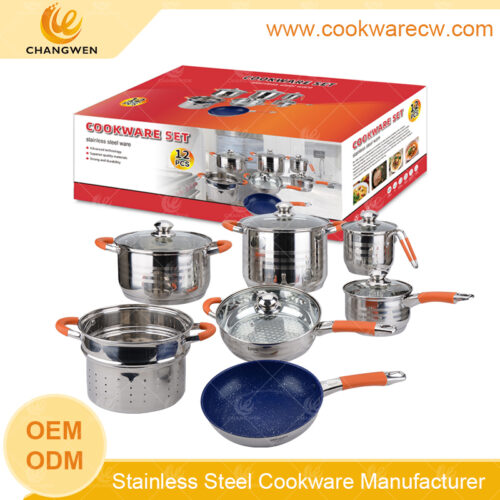
12pcs stainless steel cookware set with silicon handles coating conic frypan 24cm pasta pot in China CW-M1311
-
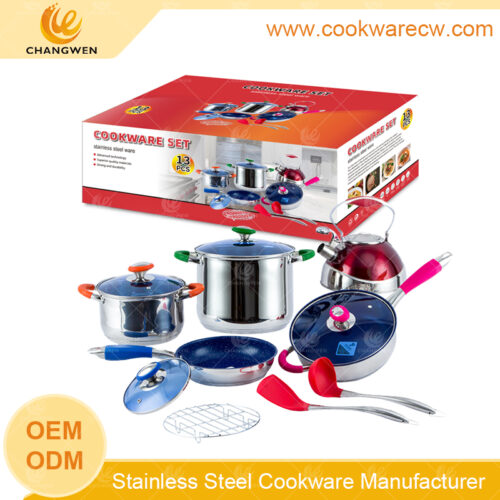
Heavy weight pots wholesale 13pcs stainless steel cookware colored silicone pots nonstick grilled frypan set with 5 steps capsule bottom 3L whistling tea kettle with frying basket kitchen tools spatula ladle CW-M1302G
-
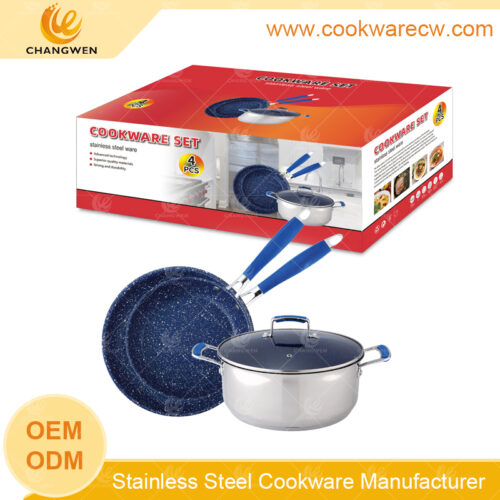
Customized color box 4pcs stainless steel blue marble coating nonstick frypan set silicone cover wholesale kitchenware CW-M0401G
-
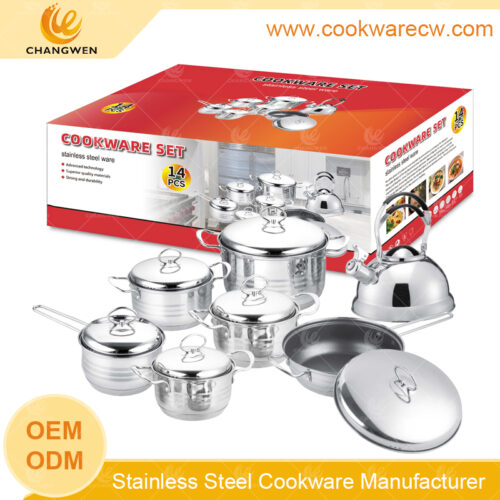
Stainless Steel Cookware Sets 14-Piece CW-M1402G
